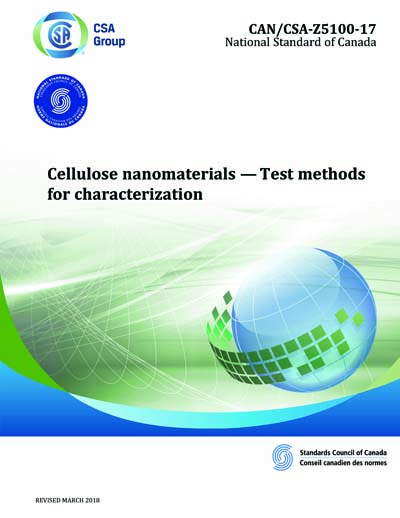Most recent
CSA Z5100-2017
Z5100-17 - Cellulose nanomaterials - Test methods for characterization
Preface
This is the second edition of CSA Z5100, Cellulose nanomaterials - Test methods for characterization. It supersedes the first edition, published in 2014. The major differences between this edition and the previous edition include: a) addition of a new test method for CMF content (consistency); b) addition of more information on recommended test methods for degree of crystallinity, colour and ISO brightness, and morphology; c) updated test methods for viscosity and rheological properties, total sulfur content, sulfate half- ester content, carboxylate content, thermal stability, and dispersibility in aqueous media; and d) alignment with new CSA standard Z5200. This Standard provides a consolidated set of test methods to characterize base cellulose nanomaterials. This Standard is the first in a series on cellulose nanomaterials intended to serve as a foundation for the development of both Canadian and international standards to facilitate introduction of cellulose nanomaterials into global markets. This is a companion standard to CSA Z5200. Cellulose nanomaterials extracted from cellulose sources, such as wood pulps, are biodegradable, sustainable, and retain the non-toxicity of cellulose. These materials have numerous potential applications in areas such as composite materials, optical films and devices, catalysts, and pharmaceuticals.Scope
1.1 This Standard describes test methods for characterization of base cellulose nanomaterials, specifically those designated as cellulose nanocrystals (CNCs), cellulose nanofibrils (CNFs) and cellulose microfibrils (CMFs). Note: These designations, particularly CNFs and CMFs, are not used consistently among cellulose nanomaterial producers and users; therefore there is some overlap as to which materials fall under which designation. 1.2 This Standard does not cover the characterization of cellulose microcrystals (CMCs). 1.3 This Standard does not cover cellulose nanomaterial-based nano-enhanced or nano-enabled products. Note: This Standard might be expanded in future editions as cellulose nanomaterial-enhanced and -enabled products move towards commercialization. See Annex C. 1.4 In this Standard, shall is used to express a requirement, i.e., a provision that the user is obliged to satisfy in order to comply with the standard; should is used to express a recommendation or that which is advised but not required; and may is used to express an option or that which is permissible within the limits of the standard. Notes accompanying clauses do not include requirements or alternative requirements; the purpose of a note accompanying a clause is to separate from the text explanatory or informative material. Notes to tables and figures are considered part of the table or figure and may be written as requirements. Annexes are designated normative (mandatory) or informative (non-mandatory) to define their application. 1.5 The values given in SI units are the units of record for the purposes of this Standard. The values given in parentheses are for information and comparison only.Content Provider
CSA America, Inc. [csa]






